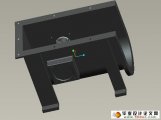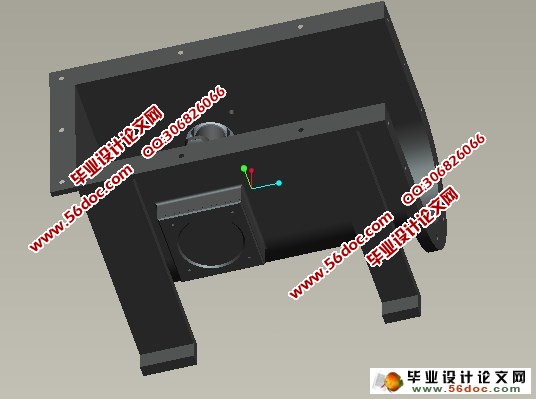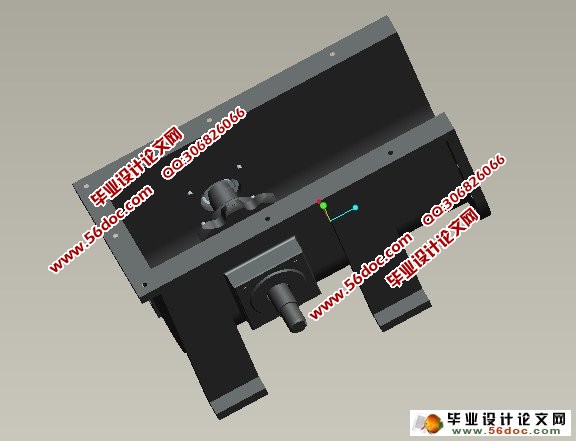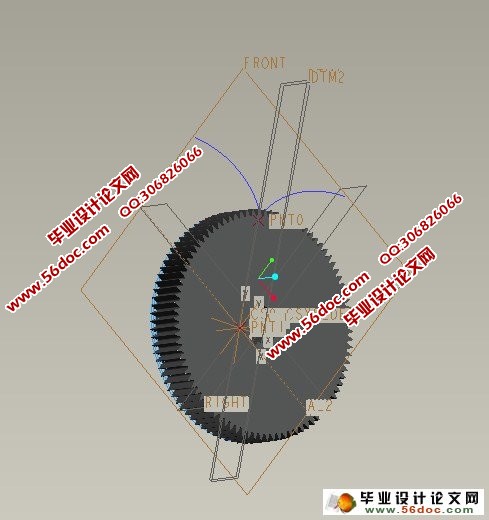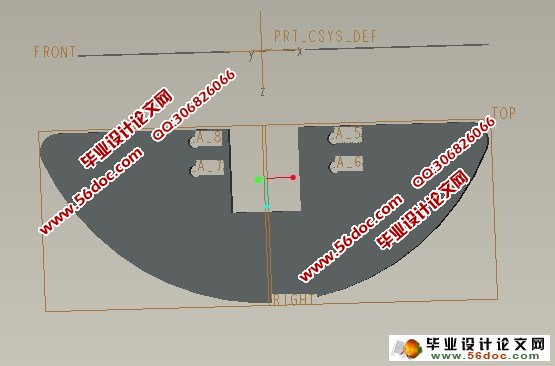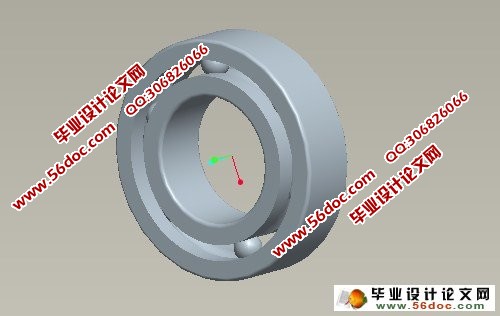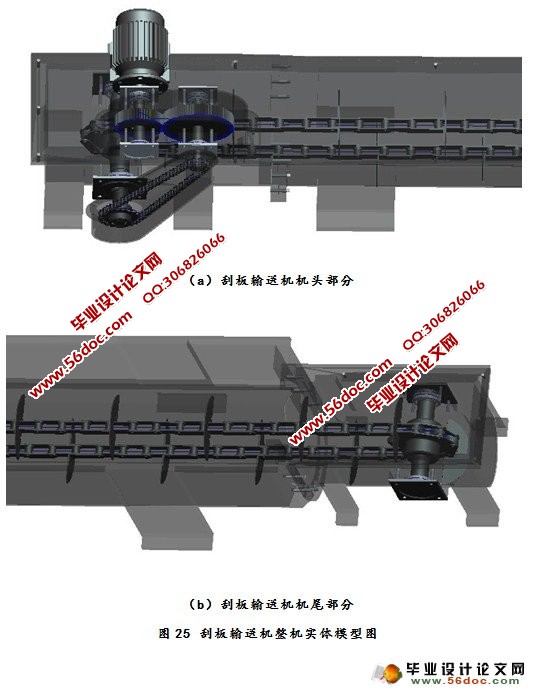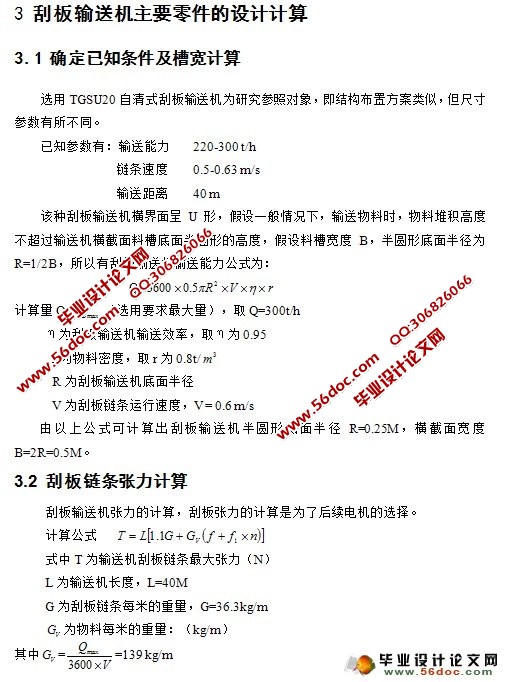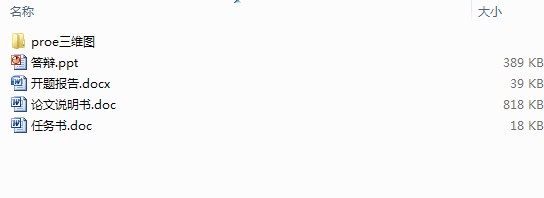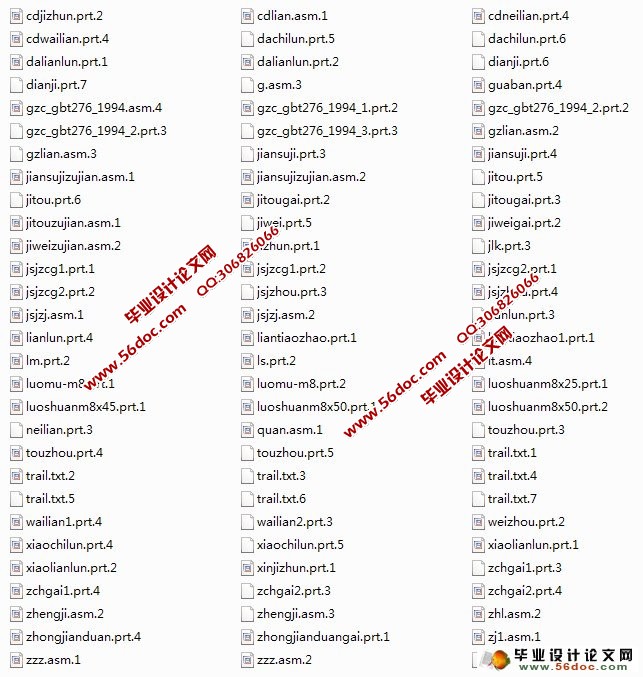基于Proe的刮板输送机的三维建模与仿真(任务书,开题报告,毕业论文说明书16200字,ProE三维图,答辩PPT)
[摘要]:刮板输送机是一种以挠性体作为牵引机构的连续动作式运输机械,主要用于输送粉尘状,小颗粒状等散状物料,主要由刮板链条、头尾链轮、机槽、进料口、卸料口、驱动装置等构件组成。对于刮板输送机的设计,目前主要采用传统的二维的设计方法,这种设计方法的主要缺点是不直观且效率低下。随着三维图形技术和计算机技术的发展,三维设计已经逐渐成为机械设计的主流。本论文从工程实际出发,利用Pro/E对刮板输送机各组成零部件进行三维建模,虚拟装配和运动仿真,改善了视觉效果,且提高设计效率。Pro/E是已被广泛应用的三维设计软件,设计人员可以利用其全相关性,参数化建模,数据管理,装配管理的特点在刮板输送机的设计建模过程中进行十分方便的修改,并可以对设计出的零部件进行直观的观察和进行干涉检查,同时可以进行虚拟装配和运动仿真,以及时发现设计中的不足。
[关键词]:刮板输送机;Pro/E;三维实体建模;虚拟装配;运动仿真;结构设计
Based on Pro/E modeling and simulation of the scraper conveyor
[Abstract] Scraper conveyor is a transport machine for continuous action witch traction mechanism is a kind of flexible body, mainly used for conveying dust, granular and other bulk materials. Its main structure by scraper chain, head and tail sprockets, shafts , the feed port , the discharge port and drive components. The design for scraper conveyor , mainly using the traditional two-dimensional design method. With the development of three-dimensional graphics technology and computer technology, three-dimensional design has become mainstream mechanical design method. This study uses Pro/E to found scraper conveyor each composition parts for three-dimensional modeling and simulation of virtual assembly and movement, improve the visual effects and the design efficiency. Pro/E is a three-dimensional design software has been widely used, design personnel can use its whole correlation, parameterized modeling, data management, management features in the assembly of the scraper conveyor design process is very convenient, and the design of the parts were observed, and can be directly on the virtual assembly and motion simulation to found in design timely
[Keywords]:Scraper conveyor;Pro/E;three-dimensional modeling;virtual assembly;motion simulation;structural design
主要研究内容
刮板输送机是粮食及饲料加工厂常用的连续输送设备,其结构主要由机头传动装置、料槽、刮板链、机尾等结构组成。本研究对目前国内外运用Pro/E建模与仿真的实例进行研究分析,比较其优缺点和可行性,通过这些分析比较结合所学专业知识,利用Pro/E对刮板输送机各组成零件进行三维建模,虚拟装配和运动仿真,以简化设计过程,改善视觉效果,和提高设计效率。
目 录
任务书………………………………………………………………………………Ⅰ
开题报告……………………………………………………………………………Ⅱ
指导教师审查意见…………………………………………………………………Ⅲ
评阅教师评语………………………………………………………………………Ⅳ
答辩会议记录………………………………………………………………………Ⅴ
中文摘要……………………………………………………………………………Ⅵ
外文摘要……………………………………………………………………………Ⅶ
1 前言…………………………………………………………………………………1
2 选题背景……………………………………………………………………………1
2.1课题的背景及其意义………………………………………………………1
2.2国内外发展状况…………………………………………………………….2
2.3 主要研究内容…………………………………………………………….............3
3 刮板运输机主要零件的设计计算…………………………………………………........4
3.1 确定已知条件及槽宽计算………………………………………………….........4
3.2 刮板链条张力计算…………………………………………………... ….............4
3.3 电机的功率计算及选择…………………………………………………….........5
3.4 动力传动方案的确定……………………………………………………….........6
3.5 轴主轴直径的初步估算…………………………………………………….........7
4刮板输送机的各零件建模………………………………………………………….......10
4.1 Pro/E三维建模简介………………………………………………………........10
4.2 Pro/E虚拟装配简介……………………………………………………….......10
4.3 刮板链的三维建模……………………………………………………….......11
4.3.1 刮板链条内外链板的三维建模…………………………………….......11
4.3.2 可装刮板外链板的三维建模……………………………………….......11
4.3.3 刮板的三维建模………………………………………………….......12
4.3.4 刮板与外链板子组件的装配……………………………………….......13
4.3.5 刮板链条的整体装配……………………………………………….......14
4.4工作链轮的实体建模……………………………………………………............14
4.5机尾的实体建模……………………………………………………............15
4.6进料口的三维实体建模…………………………………………………............17
4.7中间段的三维实体建模…………………………………………………............18
4.8机头的三维实体建模……………………………………………………............19
4.9传动链的三维实体建模…………………………………………………............20
4.9.1工作链轮内外链节的实体建模…………………………………............20
4.9.2传动链的整体装配………………………………………………............20
4.10传动链轮的三维实体建模………………………………………............21
4.11减速机箱的三维实体建模………………………………………............22
4.12轴承盖的三维实体建模………………………………………............23
4.13电机的三维实体建模………………………………………............24
4.14齿轮的三维实体建模………………………………………............24
4. 15轴承及紧固件的三维实体建模………………………………………............25
5 刮板输送机的装配…………………………………………………………………......26
5.1刮板输送机机尾部的虚拟装配……………………………………………........27
5.2刮板输送机机头部的虚拟装配……………………………………………........28
5.3减速机的虚拟装配……………………………………………………........29
5.4整体的虚拟装配……………………………………………………........30
6 刮板输送机的仿真…………………………………………………………………......32
6.1 Pro/E仿真功能简介………………………………………………………......32
6.2 刮板输送机的仿真分析…………………………………………………......33
7 结论…………………………………………………………………......34
参考文献………………………………………………………………………………......35
致谢……………………………………………………………………………………......36
|
